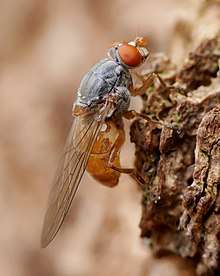Brachyopa insensilis
Brachyopa insensilis is a Palearctic species of hoverflies.[1][2] [3] [4]
| Brachyopa insensilis | |
|---|---|
 | |
| Scientific classification | |
| Kingdom: | |
| Phylum: | |
| Class: | |
| Order: | |
| Family: | |
| Subfamily: | |
| Tribe: | |
| Genus: | |
| Species: | B. insensilis |
| Binomial name | |
| Brachyopa insensilis (Collin, 1939) | |
Description
External images
For terms see Morphology of Diptera
The wing length is 6·5-7·25 mm.
Apical antennomere small and without a sensory pit. Arista almost bare. Face less produced than in Brachyopa bicolor.[5] Scutellum with microtrichia only on anterior margin. The larva is illustrated by Rotheray (1993).[6]
Distribution
Brachyopa insensilis is a Palearctic species with a wide distribution in Europe[7] and east to Tadjikistan, Siberia, Russian Far East and Kamchatka.[8]
The habitat is Abies, Quercus and Fagus forest with senile trees, but also occurs on old trees in suburban parks.[9]
Behaviour
Brachyopa insensilis is arboreal descending to visit sap runs and flowers (white umbellifers, Photinia, Prunus padus, Sorbus aria.[10] The flight period is from the beginning of May to the end of June. Brachyopa insensilis has a characteristic, rapid, zigzag flight and rarely descends lower than 3 metres from the ground. It may occur in small swarms around sap runs. Larvae feed in sap runs and rot holes.
References
- Stubbs, Alan E. & Falk, Steven J. (1983). British Hoverflies: An Illustrated Identification Guide (2nd (revised) ed.). British Entomological & Natural History Society. p. 271, xvpp. ISBN 0-9502891-3-2.
- Van Veen, M. (2004) Hoverflies of Northwest Europe: identification keys to the Syrphidae. 256pp. KNNV Publishing, Utrecht.
- Van der Goot,V.S. (1981) De zweefvliegen van Noordwest - Europa en Europees Rusland, in het bijzonder van de Benelux. KNNV, Uitgave no.32: 275pp. Amsterdam.
- Bei-Bienko, G.Y. & Steyskal, G.C. (1988) Keys to the Insects of the European Part of the USSR, Volume V: Diptera and Siphonaptera, Part I. Amerind Publishing Co., New Delhi. ISBN 81-205-0080-6.
- Coe, R.L. (1953) Diptera: Syrphidae. Handbks.ident.Br.insects, 10(1): 1-98. R.ent.Soc.London.
- Rotheray G., 1993 Colour Guide to Hoverfly Larvae Diptera, Syrphidae in Britain and Europe Dipterists Forum pdf Archived 2019-04-03 at the Wayback Machine
- Fauna Europaea
- Peck, L.V. (1988) Syrphidae. In: Soos, A. & Papp, L. (eds.) Catalogue of Palaearctic Diptera, 8: 11-230. Akad.Kiado, Budapest.
- Speight, M.C.D. (2011). "Species accounts of European Syrphidae (Diptera)" (PDF). Syrph the Net, the database of European Syrphidae. 65: 285pp.
- de Buck, N. (1990) Bloembezoek en bestuivingsecologie van Zweefvliegen (Diptera, Syrphidae) in het bijzonder voor België. Doc. Trav. IRSNB, no. 60, p. 1-167.